
WEEKEND TOUR PACKAGES FOR STUDENTS
Paris is magnificent, but it’s also super-sized, crowded, and fast-paced. Use this orientation to the City of Light to help illuminate your trip. The day plans—for visits of one to seven days—will help you prioritize the many sights. You’ll tap into Paris’ information sources for current events. Most important, you’ll learn to navigate Paris by Métro, bus, taxi, bicycle, or on foot. With the proper approach and a measure of patience, you’ll fall head over heels for Europe’s cultural capital.
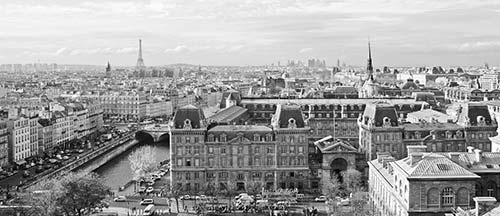
Central Paris (population 2.3 million) is circled by a ring road and split in half by the Seine River, which runs east-west. If you were on a boat floating downstream, the Right Bank (Rive Droite) would be on your right, and the Left Bank (Rive Gauche) on your left. The bull’s-eye on your map is Notre-Dame, on an island in the middle of the Seine.
Twenty arrondissements (administrative districts) spiral out from the center, like an escargot shell. If your hotel’s zip code is 75007, you know (from the last two digits) that it’s in the 7th arrondissement. The city is peppered with Métro stops, and most Parisians locate addresses by the closest stop. So in Parisian jargon, the Eiffel Tower is on la Rive Gauche (the Left Bank) in the 7ème (7th arrondissement), zip code 75007, Mo: Trocadéro (the nearest Métro stop).
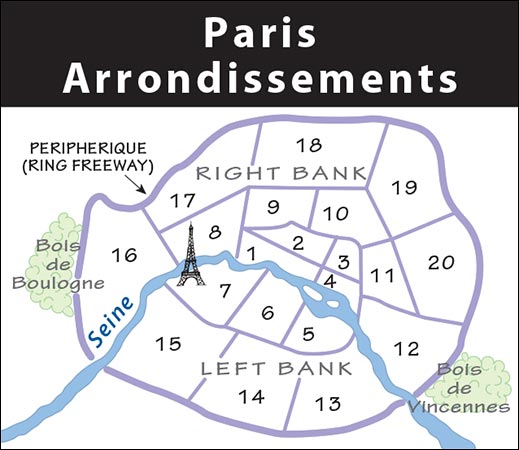
As you’re tracking down addresses, these words and pronunciations will help: arrondissement (ah-rohn-dees-mahn), Métro (may-troh), place (plahs; square), rue (rew; road), avenue (ah-vuh-new), boulevard (bool-var), and pont (pohn; bridge).
(See “Paris Neighborhoods” map, here.)
Paris is a big city, but its major sights cluster in convenient zones. Grouping your sightseeing, walks, dining, and shopping thoughtfully can save you lots of time and money.
Historic Core: This area centers on the Ile de la Cité (“Island of the City”), located in the middle of the Seine. On the Ile de la Cité, you’ll find Paris’ oldest sights, from Roman ruins to the medieval Notre-Dame and Sainte-Chapelle churches. Other sights in this area: Archaeological Crypt, Deportation Memorial, Conciergerie, flower market, Paris Plages, and the lovely island of Ile St. Louis, with appealing shops, cafés, and restaurants. Paris’ most historic riverside vendors, les bouquinistes, line both sides of the Seine as it passes Ile de la Cité.
Major Museums Neighborhood: Located just west of the historic core, this is where you’ll find the Louvre, Orsay, and Orangerie. Other sights are the Tuileries Garden and Palais Royal’s courtyards.
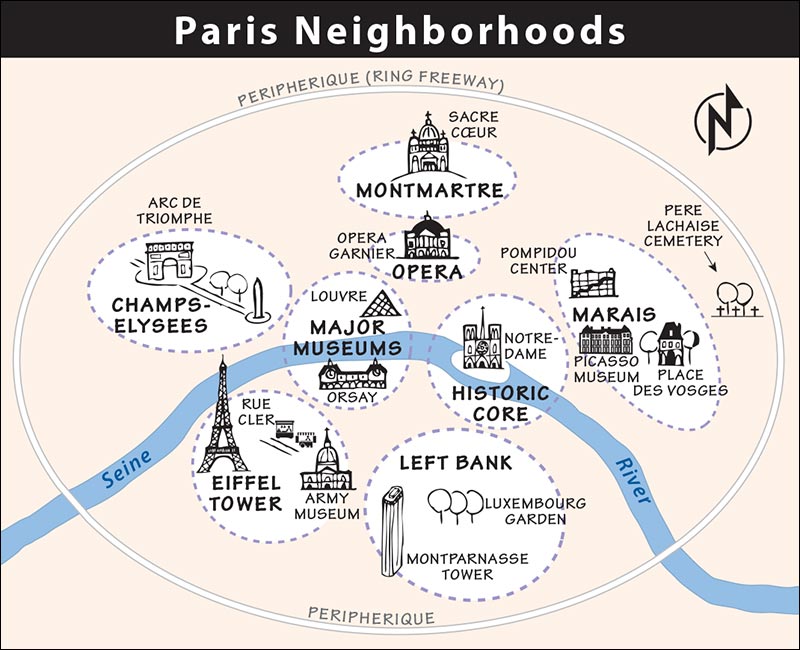
Champs-Elysées: The greatest of the many grand, 19th-century boulevards on the Right Bank, the Champs-Elysées runs northwest from Place de la Concorde to the Arc de Triomphe. Sights in this area include the Petit and Grand Palais, Hôtel Hyatt Regency (for its great city view), and La Défense with La Grande Arche.
Eiffel Tower Neighborhood: Dominated by the Eiffel Tower, this area also boasts the colorful Rue Cler (with many recommended hotels and restaurants), Army Museum and Napoleon’s Tomb, Rodin Museum, and the thriving outdoor market Marché Boulevard de Grenelle. Other sights are the Quai Branly Museum, National Maritime Museum, Architecture and Monuments Museum, and Sewer Tour. The Marmottan Museum is west of the Eiffel Tower on the Right Bank.
Opéra Neighborhood: Surrounding the Opéra Garnier, this area on the Right Bank is home to a series of grand boulevards. In the 19th century, it was modernized by Baron Haussmann into a neighborhood of wide roads lined with stately buildings (see sidebar on here). Though these days it roars with traffic, there are still hints of Paris, circa 1870, when it was the capital of the world. Along with key sights such as the Opéra Garnier and Jacquemart-André Museum, the neighborhood offers high-end shopping (Galeries Lafayette department store, around Place de la Madeleine and Place Vendôme, and at the covered passages of Choiseul and Ste. Anne), plus the Fragonard Perfume Museum.
Left Bank: The Left Bank is home to...the Left Bank. Anchored by the large Luxembourg Garden (near numerous recommended hotels and eateries), the Left Bank is the traditional neighborhood of Paris’ intellectual, artistic, and café life. Other sights: the Latin Quarter, Cluny Museum, St. Germain-des-Prés and St. Sulpice churches, Panthéon, Montparnasse Tower, Catacombs, Delacroix Museum, and the Jardin des Plantes park. This is also one of Paris’ best shopping areas (see the Sèvres-Babylone to St. Sulpice shopping stroll on here).
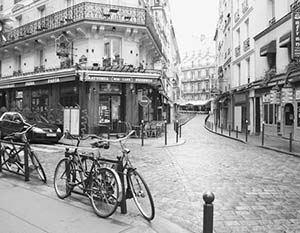
Marais: Stretching eastward to Bastille along Rue de Rivoli/Rue St. Antoine, this neighborhood has lots of recommended restaurants and hotels, shops, the delightful Place des Vosges, and artistic sights such as the Pompidou Center and Picasso Museum. The area is known for its avant-garde boutiques and residents. Other Marais sights: Jewish Art and History and Carnavalet museums, Victor Hugo’s House, Holocaust Memorial, Promenade Plantée park, Père Lachaise Cemetery, the Marché des Enfants Rouges covered market, and the outdoor markets at Bastille and Place d’Aligre.
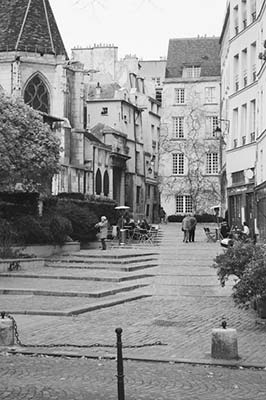
Montmartre: This hill, topped by the bulbous white domes of Sacré-Cœur, hovers on the northern fringes of your Paris map. Home to many recommended hotels and restaurants, it still retains some of the untamed charm that once drew Impressionist painters and turn-of-the-century bohemians. Other sights are the Dalí and Montmartre museums, Moulin Rouge, Pigalle, and nearby Puces St. Ouen flea market.
In the planning sections that follow, I’ve listed sights in descending order of importance. If you have only one day, just do Day 1; for two days, add Day 2; and so on. When deciding where to plug in Versailles, remember that the main palace is closed on Mondays and especially crowded on Sundays and Tuesdays—try to avoid these days. For other itinerary considerations on a day-by-day basis, check the “Daily Reminder” on here.
To fit in Versailles on a three-day visit, try it either on the morning of the third day or the afternoon of the second day.
Morning: Follow my Historic Paris Walk, featuring Ile de la Cité, Notre-Dame, the Latin Quarter, and Sainte-Chapelle.
Afternoon: Tour the Louvre.
Evening: Enjoy the Place du Trocadéro scene and a twilight ride up the Eiffel Tower.
Morning: Follow my Champs-Elysées Walk from the Arc de Triomphe down the grand Avenue des Champs-Elysées to the Tuileries Garden.
Midday: Cross the pedestrian bridge from the Tuileries Garden, then tour the Orsay Museum.
Afternoon: Tour the Rodin Museum, or the Army Museum and Napoleon’s Tomb.
Evening: Take one of the tours by bus, taxi, or retro-chic Deux Chevaux car (see here). (If you’re staying more than two days, save this for your last-night finale.)
Morning: Catch the RER suburban train by 8:00 to arrive early at Versailles (before it opens at 9:00), then tour the château and sample the gardens.
Afternoon: Versailles can take up a full sightseeing day, so be realistic. If you plan to do anything once back in Paris, consider a sight near one of the RER-C stations: the Army Museum and Napoleon’s Tomb or Rodin Museum (near RER-C stop: Invalides), or the Musée d’Orsay or this book’s Left Bank Walk (near RER-C stop: St. Michel).
Evening: Cruise the Seine River or have dinner on Ile St. Louis, then take a floodlit walk by Notre-Dame.
Morning: Follow this book’s Historic Paris Walk, featuring Ile de la Cité, Notre-Dame, the Latin Quarter, and Sainte-Chapelle. If you enjoy medieval art, visit the Cluny Museum.
Afternoon: Tour the Opéra Garnier, and end your day enjoying the glorious rooftop views at the Galeries Lafayette or Printemps department stores.
Evening: Cruise the Seine River.
Morning: Tour the Louvre (arrive 30 minutes before opening). Have coffee or lunch at Café le Nemours (across the street from the Louvre).
Afternoon: Follow this book’s Champs-Elysées Walk from the Arc de Triomphe downhill along the incomparable Avenue des Champs-Elysées to the Tuileries Garden, and possibly the Orangerie Museum. Reversing the morning and afternoon activities on this day could also work well.
Evening: Enjoy dinner on Ile St. Louis, then a floodlit walk by Notre-Dame.
Midday: Tour the Rodin Museum (café lunch in gardens).
Afternoon: Visit the Army Museum and Napoleon’s Tomb, then take this book’s Rue Cler Walk and relax at a café.
Evening: Take one of the nighttime tours by taxi, bus, or retro-chic Deux Chevaux car.
Morning: Ride the RER suburban train to arrive early at Versailles and tour the palace’s interior.
Midday: Have lunch in the gardens at Versailles.
Afternoon: Spend the afternoon touring the gardens, Trianon Palaces, and Domaine de Marie-Antoinette, or return to Paris and do this book’s Montmartre Walk.
Evening: Have dinner wherever you are—in Versailles town or on Montmartre.
Morning: Follow this book’s Marais Walk and tour the Carnavalet Museum. Have lunch on Place des Vosges or Rue des Rosiers.
Afternoon: Choose from these Marais sights—the Picasso Museum, Pompidou Center, Jewish Art and History Museum, or Père Lachaise Cemetery.
Evening: Enjoy the Place du Trocadéro scene and a twilight ride up the Eiffel Tower.
Morning: Take an Impressionist escape to Giverny or Auvers-sur-Oise, or take a day trip to historic Chartres, or Vaux-le-Vicomte.
Late Afternoon: If you get back to Paris in time, follow this book’s Left Bank Walk (featuring art galleries, boutiques, historic cafés, and grand boulevards), mix in some shopping (see the Sèvres-Babylone to St. Sulpice stroll on here), then relax in Luxembourg Garden or at a nearby café (see “Les Grands Cafés de Paris,” here).
Evening: Join the parade along the Champs-Elysées (which offers a different scene at night than the daytime walk you enjoyed on Day 2). If you haven’t hiked to the top of the Arc de Triomphe yet, consider doing it by twilight.
Choose from:
More shopping and cafés
Bus #69 tour followed by Père Lachaise Cemetery
Montmartre and Sacré-Cœur
Marmottan or Jacquemart-André museums
Day trip to Vaux-le-Vicomte and/or Fontainebleau
Day trip to Disneyland Paris
Evening: Night bus or boat tour (whichever you have yet to do)
Paris’ tourist offices (abbreviated as “TI” in this book) can provide useful information but may have long lines (www.parisinfo.com). TIs sell Museum Passes and individual tickets to sights (see “Sightseeing Strategies” on here).
Paris has several TI locations, including Pyramides (daily May-Oct 9:00-19:00, Nov-April 10:00-19:00, 25 Rue des Pyramides—at Pyramides Métro stop between the Louvre and Opéra), Gare du Nord (daily 8:00-18:00, near track 19), Gare de Lyon (Mon-Sat 8:00-18:00, closed Sun, across from track M), Gare de l’Est (Mon-Sat 8:00-19:00, closed Sun, across from track 1), and two in Montmartre (21 Place du Tertre, daily 10:00-18:00, covers only Montmartre sights and doesn’t sell Museum Passes, tel. 01 42 62 21 21; and at the Anvers Métro stop, full-service office, daily 10:00-18:00). In summer, TI kiosks may pop up in the squares in front of Notre-Dame and Hôtel de Ville.
Both airports have handy TIs with long hours and short lines.
Event Listings: Several French-only but easy-to-decipher periodicals list the most up-to-date museum hours, art exhibits, concerts, festivals, plays, movies, and nightclubs (for tips on deciphering the listings, see here). The best is the weekly Pariscope magazine; L’Officiel des Spectacles is similar (available at any newsstand). The Paris Voice, with snappy English-language reviews of concerts, plays, and current events, is available online only at www.parisvoice.com.
For a comprehensive rundown of the city’s train stations and airports, and for information on parking a car, see the Paris Connections chapter.
Theft Alert: Thieves thrive near famous monuments and on Métro and train lines that serve airports and high-profile tourist sights. Beware of pickpockets working busy lines (e.g., at ticket windows at train stations). Look out for groups of young girls who swarm around you (be very firm—even forceful—and walk away). Smartphones and tablets are thief magnets anytime, so be aware whenever you’re using one or holding it up to take a picture.
It’s smart to wear a money belt, put your wallet in your front pocket, loop your day bag over your shoulders, and keep a tight hold on your purse or shopping bag. When wearing a daypack, don’t keep valuables in the outer pockets, and don’t mark yourself as a tourist by wearing it on your front. Muggings are rare, but they do occur. If you’re out late, avoid the dark riverfront embankments and any place where the lighting is dim and pedestrian activity is minimal.
Paris has taken action to combat crime by stationing police at monuments, on streets, and on the Métro, and installing security cameras at key sights.
Tourist Scams: Be aware of the latest tricks, such as the “found ring” scam (a con artist pretends to find a “pure gold” ring on the ground and offers to sell it to you) or the “friendship bracelet” scam (a vendor asks you to help with a demo, makes a bracelet on your arm that you can’t easily remove, and then asks you to pay for it).
Distractions by a stranger—often a “salesman,” someone asking you to sign a petition, or someone posing as a deaf person to show you a small note to read—can all be tricks that function as a smokescreen for theft. As you try to wriggle away from the pushy stranger, an accomplice picks your pocket.
To all these scammers, simply say “no” firmly and step away purposefully. For reports from my readers on the latest scams, go to https://community.ricksteves.com/travel-forum/tourist-scams.
Pedestrian Safety: Parisian drivers are notorious for ignoring pedestrians. Look both ways and be careful of seemingly quiet bus/taxi lanes. Don’t assume you have the right of way, even in a crosswalk. When crossing a street, keep your pace constant and don’t stop suddenly. By law, drivers are allowed to miss pedestrians by up to just one meter—a little more than three feet (1.5 meters in the countryside). Drivers calculate your speed so they won’t hit you, provided you don’t alter your route or pace.
Watch out for bicyclists and electric cars. Cyclists ride in specially marked bike lanes on wide sidewalks and can also use lanes reserved for buses and taxis. Bikes commonly go against traffic, so always look both ways, even on one-way streets. Paris’ popular and cheap short-term electric-car rental program (Autolib’) has put many of these small, silent machines on the streets—pay attention.
Busy Parisian sidewalks are like freeways, so conduct yourself as if you were a foot-fueled-car: Stick to your lane, look to the left before passing a slow-moving pedestrian, and if you need to stop, look for a safe place to pull over.
Medical Help: There are a variety of English-speaking resources for medical help in Paris, including doctors who will visit your hotel. For a complete list, see here.
Avoiding Lines at Sights: Lines at Paris’ major sights can be long. Consider the worthwhile Paris Museum Pass, which covers most sights in the city and allows you to skip ticket lines. You can also buy tickets in advance for certain sights. For more on these options, see here.
Free Wi-Fi: You’ll find free wireless hotspots at many cafés and at hundreds of public hotspots (including parks, squares, and museums). In a café, order something, then ask the waiter for the Wi-Fi (“wee-fee”) password (“mot de passe”; moh duh pahs).
Most public parks offer free Wi-Fi (look for purple Zone Wi-Fi signs). The one-time registration process is easy: Select the Wi-Fi network (usually called “Paris_WIFI” plus a number), enter your name and email address, check the “j’accepte” box, and click “Me connecter.” You get two hours per connection.
The Orange network also has many hotspots and offers a free two-hour pass. If you come across one, click “Select Your Pass” to register.
Useful Apps: Gogo Paris is an intriguing app that reviews trendy places to eat, drink, relax, and sleep in Paris (www.gogocityguides.com/paris).
 For free audio versions of some of the self-guided tours in this book (the Historic Paris Walk, and tours of the Louvre Museum, Orsay Museum, and Versailles Palace), get the Rick Steves Audio Europe app (for details, see here).
For free audio versions of some of the self-guided tours in this book (the Historic Paris Walk, and tours of the Louvre Museum, Orsay Museum, and Versailles Palace), get the Rick Steves Audio Europe app (for details, see here).
Bookstores: Paris has several English-language bookstores. My favorites include Shakespeare and Company (some used travel books, Mon-Sat 10:00-23:00, Sun 11:00-23:00, 37 Rue de la Bûcherie, across the river from Notre-Dame, Mo: St. Michel, tel. 01 43 25 40 93; described on here); W. H. Smith (Mon-Sat 9:00-19:00, Sun 12:30-19:00, 248 Rue de Rivoli, Mo: Concorde, tel. 01 44 77 88 99); and San Francisco Book Company (used books only, Mon-Sat 11:00-21:00, Sun 14:00-19:30, 17 Rue Monsieur le Prince, Mo: Odéon, tel. 01 43 29 15 70).
Baggage Storage: Lockers are available at several City Locker locations in central Paris (€10-16/day, daily 8:00-22:00, book ahead online or take your chances and drop in, details and locations at www.city-locker.com).
Public WCs: Most public toilets are free. If it’s a pay toilet, the price will be clearly indicated. If the toilet is free but there’s an attendant, it’s polite to leave a tip of €0.20-0.50. Booth-like toilets on the sidewalks provide both relief and a memory (don’t leave small children inside unattended). The restrooms in museums are free and the best you’ll find. Bold travelers can walk into any sidewalk café like they own the place and find the toilet downstairs or in the back. Or do as the locals do—order a shot of espresso (un café) while standing at the café bar (then use the WC with a clear conscience). Keep toilet paper or tissues with you, as some WCs are poorly stocked.
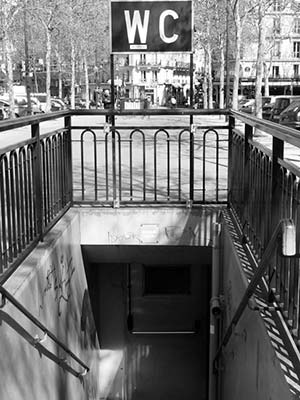
Tobacco Stands (Tabacs): These little kiosks—usually just a counter inside a café—are handy and very local. Most sell public-transit tickets, cards for parking meters, postage stamps (though not all sell international postage), prepaid phone cards, and...oh yeah, cigarettes. (For more on this slice of Parisian life, see here. For details on parking cards, see here.) To find a kiosk, just look for a Tabac sign and the red cylinder-shaped symbol above certain cafés. A tabac can be a godsend for avoiding long ticket lines at the Métro, especially at the end of the month when ticket booths get crowded with locals buying next month’s pass.
Updates to This Book: For updates to this book, check www.ricksteves.com/update.
Paris is easy to navigate. Your basic choices are Métro (in-city subway), RER (suburban rapid transit tied into the Métro system), public bus, and taxi. (Also consider the hop-on, hop-off bus and boat tours, described under “Tours in Paris,” later.)
You can buy tickets and passes at Métro stations and at many tabacs. Staffed ticket windows in stations are gradually being phased out in favor of ticket machines, so expect some stations to have only machines and an information desk. Machines accept coins, small bills of €20 or less, and chip-and-PIN cards (no American magnetic-stripe or chip-and-signature cards). If a ticket machine is out of order or if you’re out of change, buy tickets at a tabac.
Public-Transit Tickets: The Métro, RER, and buses all work on the same tickets. You can make as many transfers as you need on a single ticket, except when transferring between the Métro/RER system and the bus system, which requires using an additional ticket. A single ticket costs €1.80. To save money, buy a carnet (kar-nay) of 10 tickets for €14.10 (cheaper for ages 4-10). Carnets can be shared among travelers. Kids under four ride free.
Passe Navigo: This chip-embedded card costs a one-time €5 fee (plus another €5 for the required photo; photo booths are in major Métro stations). The weekly unlimited pass (Navigo Semaine) costs €21.25 and covers all forms of transit in central Paris from Monday to Sunday (expiring on Sunday, even if you buy it on, say, a Thursday). A monthly pass that also covers longer trips is available. To use the Navigo, touch the card to the purple pad, wait for the green validation light and the “ding,” and you’re on your way. You can buy your Passe Navigo at any Métro station in Paris (for more details, visit www.ratp.fr).
Navigo or Carnet? It’s hard to beat the carnet. Two 10-packs of carnets—enough for most travelers staying a week—cost €28.20, are shareable, and don’t expire. Though similar in price, the Passe Navigo is more of a hassle to buy, cannot be shared, and only becomes worthwhile for visitors who stay a full week (or more), start their trip early in the week (on a Monday or Tuesday), and use the system a lot.
Other Passes: A handy one-day bus/Métro pass (called Mobilis) is available for €7. If you are under 26 and in Paris on a Saturday or Sunday, you can buy an unlimited daily transit pass called Ticket Jeunes Week-end for the unbeatable price of €3.85. To justify the Paris Visite travel card (over carnets), you’ll have to do lots of traveling, though they do offer minor reductions at minor sights (1 day-€11.15, 2 days-€18.15, 3 days-€24.80, 5 days-€35.70).
In Paris, you’re never more than a 10-minute walk from a Métro station. Europe’s best subway system allows you to hop from sight to sight quickly and cheaply (runs Sun-Thu 5:30-24:30, Fri-Sat 5:30-2:00 in the morning, www.ratp.fr). Learn to use it. Begin by studying the color Métro map at the beginning of this book.
Using the Métro System: To get to your destination, determine the closest “Mo” stop and which line or lines will get you there. The lines are color-coded and numbered, and you can tell their direction by the end-of-the-line stops. For example, the La Défense/Château de Vincennes line, also known as line 1 (yellow), runs between La Défense, on its west end, and Vincennes on its east end. Once in the Métro station, you’ll see the color-coded line numbers and/or blue-and-white signs directing you to the train going in your direction (e.g., direction: La Défense). Insert your ticket in the automatic turnstile, reclaim your ticket, pass through, and keep it until you exit the system (some stations require you to pass your ticket through a turnstile to exit). The smallest stations are unstaffed but have ticket machines (coins are essential unless you have a chip-and-PIN card). Be warned that fare inspectors regularly check for cheaters, accept absolutely no excuses, and have portable credit card machines to fine you on the spot: Keep that ticket or pay a minimum fine of €45.
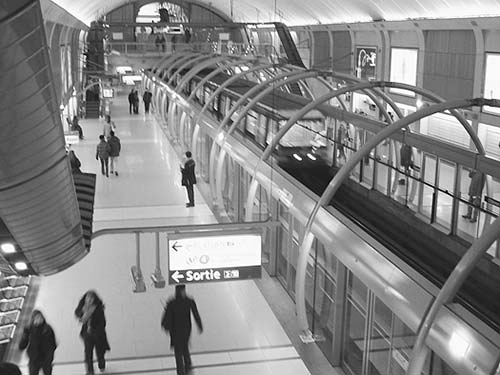
Be prepared to walk significant distances within Métro stations (especially when you transfer). Transfers are free and can be made wherever lines cross, provided you do so within 1.5 hours. When you transfer, follow the appropriately colored line number and end-of-the-line stop to find your next train, or look for orange correspondance (connection) signs that lead to your next line.
When you reach your destination, look for the blue-and-white sortie signs pointing you to the exit. Before leaving the station, check the helpful plan du quartier (map of the neighborhood) to get your bearings. At stops with several sorties, you can save time by choosing the best exit.
After you finish the entire ride and exit onto the street, toss or tear your used ticket so you don’t confuse it with unused tickets.
Métro Resources: Métro maps are free at Métro stations and included on freebie Paris maps at your hotel. Several good online tools can also help you navigate the public-transit system. The website Metro.paris provides an interactive map of Paris’ sights and Métro lines, with a trip-planning feature and information about each sight and station’s history (www.metro.paris). The free RATP mobile app (in English, download at www.ratp.fr) and the more user-friendly Kemtro app (www.kemtro.com) can estimate Métro travel times, help you locate the best station exit, and tell you when the next bus will arrive, among other things.
Beware of Pickpockets: Thieves dig the Métro and RER. If your pocket is picked as you pass through a turnstile, you end up stuck on the wrong side while the thief gets away. Stand away from Métro doors to avoid being a target for a theft-and-run just before the doors close. Any jostling or commotion—especially when boarding or leaving trains—is likely the sign of a thief or a team of thieves in action. Make any fare inspector show proof of identity (ask locals for help if you’re not certain). Keep your bag close, hang on to your smartphone, and never show anyone your wallet. For more tips, see here.
The RER (Réseau Express Régionale; air-ay-air) is the suburban arm of the Métro, serving outlying destinations such as Versailles, Disneyland Paris, and the airports. These routes are indicated by thick lines on your subway map and identified by the letters A, B, C, and so on.
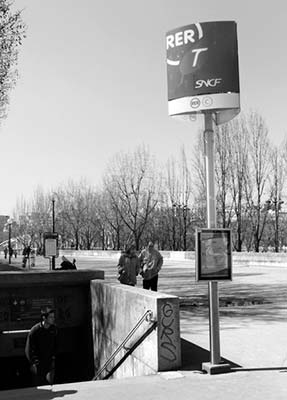
Within the city center, the RER works like the Métro and can be speedier if it serves your destination directly, because it makes fewer stops. Métro tickets and the Passe Navigo card are good on the RER when traveling in the city center. You can transfer between the Métro and RER systems with the same ticket. But to travel outside the city (to Versailles or the airport, for example), you’ll need a separate, more expensive ticket. Unlike the Métro, not every train stops at every station along the way; check the sign or screen over the platform to see if your destination is listed as a stop (“toutes les gares” means it makes all stops along the way), or confirm with a local before you board. For RER trains, you may need to insert your ticket in a turnstile to exit the system.
Paris’ excellent bus system is worth figuring out (www.ratp.fr). Buses don’t seem as romantic as the famous Métro and are subject to traffic jams, but savvy travelers know that buses can have you swinging through the city like Tarzan in an urban jungle.
Buses require less walking and fewer stairways than the Métro, and you can see Paris unfold as you travel. Bus stops are everywhere, and every stop comes with all the information you need: a good city bus map, route maps showing exactly where each bus goes that uses the stop, a frequency chart and schedule, a plan du quartier map of the immediate neighborhood, and a soirées map explaining night service, if available. Bus-system maps are also available in any Métro station (and in the Paris Pratique map book sold at newsstands). For longer stays, consider buying Le Bus book of bus routes.
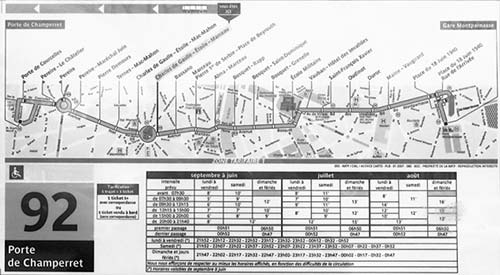
Using the Bus System: Buses use the same tickets and passes as the Métro and RER. One Zone 1 ticket buys you a bus ride anywhere in central Paris within the freeway ring road (le périphérique). Use your Métro ticket or buy one on board for €0.20 more, though note that tickets bought on board are sans correspondance, which means you can’t use them to transfer to another bus. (The ticket system has a few quirks—see “More Bus Tips,” later.)
Paris bus stops are getting a facelift, and they are looking sharp; at some locations, you can charge your phone while you wait. Board your bus through the front door. (Families with strollers can use any doors—the ones in the center of the bus are wider. To open the middle or back doors on long buses, push the green button located by those doors.) Validate your ticket in the machine and reclaim it. With a Passe Navigo, scan it on the purple touchpad. Keep track of which stop is coming up next by following the on-board diagram or listening to recorded announcements. When you’re ready to get off, push the red button to signal you want a stop, then exit through the central or rear door. Even if you’re not certain you’ve figured out the system, do some joyriding.
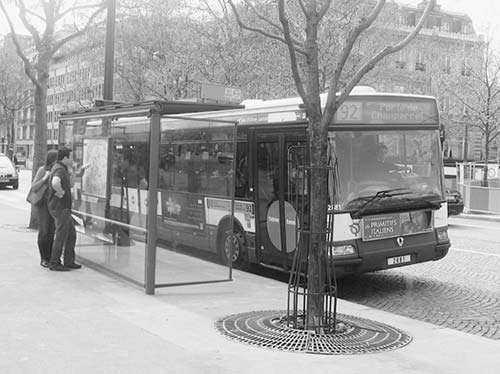
More Bus Tips: Avoid rush hour (Mon-Fri 8:00-9:30 & 17:30-19:30), when buses are jammed and traffic doesn’t move. While the Métro shuts down at about 24:30 (Sun-Thu, later Fri-Sat), some buses continue much later (called Noctilien lines, www.noctilien.fr). Not all city buses are air-conditioned, so they can become rolling greenhouses on summer days. Carnet ticket holders—but not those buying individual tickets on the bus—can transfer from one bus to another on the same ticket (within 1.5 hours, revalidate your ticket on the next bus), but you can’t do a round-trip or hop on and off on the same line. You can use the same ticket to transfer between buses and tramlines, but you can’t transfer between the bus and Métro/RER systems (it’ll take two tickets).
For a list of Paris’ most scenic and convenient routes, see here. I’ve also listed the handiest bus routes for each recommended hotel neighborhood in the Sleeping in Paris chapter.
Parisian taxis are reasonable, especially for couples and families. The meters are tamper-proof. Fares and supplements (described in English on the rear windows) are straightforward and tightly regulated.
A taxi can fit three people comfortably. Cabbies are legally required to accept four passengers, though they don’t always like it. If you have five in your group, you can book a larger taxi in advance (your hotelier can call), or try your luck at a taxi stand. Beyond three passengers, expect to pay €3 extra per person. For a sample taxi tour of the city at night, see here.
Rates: All Parisian taxis start with €2.60 on the meter and have a minimum charge of €7. A 20-minute ride (e.g., Bastille to the Eiffel Tower) costs about €20 (versus about €1.40/person to get anywhere in town using a carnet ticket on the Métro or bus). Drivers charge higher rates at rush hour, at night, all day Sunday, for extra passengers (see above), and to the airport. The first piece of luggage that goes in the trunk is free, but after that it’s €1 per bag (charge won’t appear on the meter, but it is legitimate). To tip, round up to the next euro (at least €0.50). The A, B, or C lights on a taxi’s rooftop sign correspond to hourly rates, which vary with the time of day and day of the week (for example, the A rate of €32.50/hour applies Mon-Sat 10:00-17:00). Tired travelers need not bother with these mostly subtle differences in fares—if you need a cab, take it.
Uber-like Services: Thanks to strong taxi unions and because they can’t use bus lanes to speed about, Uber and other ride services can’t effectively compete with traditional taxis in Paris.
How to Catch un Taxi: You can try waving down a taxi, but it’s often easier to ask someone for the nearest taxi stand (“Où est une station de taxi?”; oo ay ewn stah-see-ohn duh tahk-see). Taxi stands are indicated by a circled “T” on good city maps and on many maps in this book. To order a taxi in English, call the reservation line for the G7 cab company (tel. 01 41 27 66 99), or ask your hotelier or waiter to call for you. When you summon a taxi by phone, the meter starts running as soon as the call is received, often adding €6 or more to the bill. Smartphone users can book a taxi using the cab company’s app, which also provides approximate wait times (surcharge similar to booking by phone). To download an app, search for either “Taxi G7” or “Taxis Bleus” (the two major companies, both available in English).
Taxis are tough to find during rush hour, when it’s raining, on weekend nights, or on any night after the Métro closes (Sun-Thu at 24:30, later on Fri-Sat). If you need to catch a train or flight early in the morning, book a taxi the day before (especially for weekday departures). Some taxi companies require a €5 reservation fee by credit card for weekday morning rush-hour departures (7:00-10:00) and only have a limited number of reservation spots.
Paris is surprisingly easy by bicycle. The city is flat, and riders have access to more than 370 miles of bike lanes and many of the priority lanes for buses and taxis (be careful on these). You can rent from a bike-rental shop or use the city-operated Vélib’ bikes—details are below. All bike-rental shops have good route suggestions. I biked along the river from Notre-Dame to the Eiffel Tower in 15 wonderfully scenic minutes. The new riverside promenade between the Orsay Museum and Pont de l’Alma is magnificent for biking.
Urban bikers will find Paris a breeze. First-timers will get the hang of it quickly enough by following some simple rules. Always stay to the right in your lane, bike single-file, stay off sidewalks, watch out for opening doors on parked cars, signal with your arm before making turns, and use bike paths when available. Obey the traffic laws as if you were driving a car. Parisians use the same road rules as Americans, with two exceptions: When passing vehicles or other bikes, always pass on the left (it’s illegal to pass on the right); and where there is no stoplight, always yield to traffic merging from the right, even if you’re on a major road and the merging driver is on a side street. You’ll find a bell on your bike; use it like a horn to warn pedestrians who don’t see you.
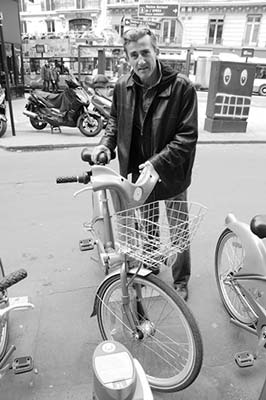
Sundays are peaceful for pedaling, when the city’s “Paris Respire” program opens up some streets to cyclists and rollerbladers (cars are banned) from 9:00 to 17:00. Participating neighborhoods include the Marais, Montmartre, the Rue Mouffetard area east of Luxembourg Garden, and the Rue Daguerre area (near the Denfert-Rochereau Métro station). Also open are sections of the small roads directly bordering the Seine—on the Left Bank from the Eiffel Tower to the Orsay and also outside of the Paris Plages (see here), on the Right Bank between the Louvre and Gare de Lyon. Neighborhood bike-path maps are available at www.paris.fr (search for “Paris respire”). The TIs have a helpful “Paris à Vélo” map, which shows all the dedicated bike paths. Many other versions are available for sale at newsstand kiosks, some bookstores, and department stores.
Rental Bikes: The following companies rent bikes to individuals and offer organized bike tours (see “Bike Tours,” later) and general tips about cycling in Paris. Bike About Tours is your best bet for bike rental, with good information and kid-friendly solutions such as baby seats, tandem attachments, and kid-sized bikes. Their shop, called The Yellow Jersey Café, offers bikes, tours, and artisan coffee (bike rental—€15/day during office hours, €20/24 hours, includes lock and helmet; daily mid-Feb-Nov 9:00-17:00, closed Dec-mid-Feb; shop/café at 17 Rue du Pont Louis Philippe, Mo: Hôtel de Ville, tel. 06 18 80 84 92, www.bikeabouttours.com). Fat Tire Bike Tours has a limited supply of bikes for rent, so call ahead to check availability (€4/hour, €25/24 hours, includes lock and helmet, photo ID and credit-card imprint required for deposit, €2/day rental discount with this book, maximum 2 discounts per book; office open daily 9:00-18:30, May-Aug bike rental only after 11:30 as priority is given to those taking a tour, 24 Rue Edgar Faure—see map on here, Mo: Dupleix, tel. 01 82 88 80 94, www.paris.fattirebiketours.com/paris).
Vélib’ Bikes: The city’s Vélib’ program (from vélo + libre = “bike freedom” or “free bike”) gives residents and foreigners alike access to more than 20,000 bikes at nearly 1,500 stations scattered around the city. While the curbside stations only accept American Express or chip-and-PIN credit cards, any kind of credit card will work if you buy a subscription in advance online at en.velib.paris.fr. The subscription process is in English and easy to follow: Click on “Subscriptions and Fees,” then scroll down to select the “Short-Term Subscription” to create a PIN, pay, and get an ID number (€1.70/1 day, €8/7 days, tel. 01 30 79 79 30). To pick up a bike, go to any bike rack, enter your ID number and PIN at the machine (all have English instructions), and away you go! Make sure to pick a bike in working order; if a bike has a problem, locals will turn the seat backwards.
 To sightsee on your own, download my free audio tours that illuminate some of Paris’ top sights and neighborhoods, including the Historic Paris Walk, Louvre Museum, Orsay Museum, and Versailles Palace (see sidebar on here for details).
To sightsee on your own, download my free audio tours that illuminate some of Paris’ top sights and neighborhoods, including the Historic Paris Walk, Louvre Museum, Orsay Museum, and Versailles Palace (see sidebar on here for details).
City Vision offers bus tours of Paris, day and night. I’d consider them only for their nighttime tour (see here) or for tricky-to-reach day trips (such as Vaux-le-Vicomte). During the day, you’ll get a better value and more versatility by taking a hop-on, hop-off tour by bus (described next) or Batobus boat (see “By Boat,” later), which provide transportation between sights.
Double-decker buses connect Paris’ main sights, giving you an easy once-over of the city with a basic recorded commentary, punctuated with vintage French folk songs. You can hop off at any stop, tour a sight, then hop on a later bus. It’s dang scenic, but only if you get a top-deck seat and the weather’s decent. Because of traffic and stops, these buses can be dreadfully slow. (Busy sightseers will do better using the Métro to connect sights.) On the plus side, because the buses move so slowly, you have time to read my sight descriptions, making this a decent orientation tour.
Of the several different hop-on, hop-off bus companies, L’OpenTour is best. They offer frequent service on four routes covering central Paris. You can even transfer between routes with one ticket. Look up the various routes and stops either on their website or by picking up a brochure (available at any TI or on one of their bright yellow buses). Their Paris Grand Tour (green route) offers the best introduction and most frequent buses (every 10 minutes). Other routes run a bit less frequently (every 15-30 minutes). You can catch the bus at just about any major sight (look for the Open Bus icon on public transit bus shelters and signs). Buy tickets from the driver (1 day-€32, 2 days-€36, 3 days-€40, kids 4-11-€16 for 1 or 2 days, allow 2 hours per route, tel. 01 42 66 56 56, www.paris.opentour.com). A combo-ticket covers the Batobus boats, described later (1 day-€41, 2 days-€45, 3 days-€49, kids 4-11-€20 for 2 or 3 days). L’OpenTour also runs night illumination tours (see here).
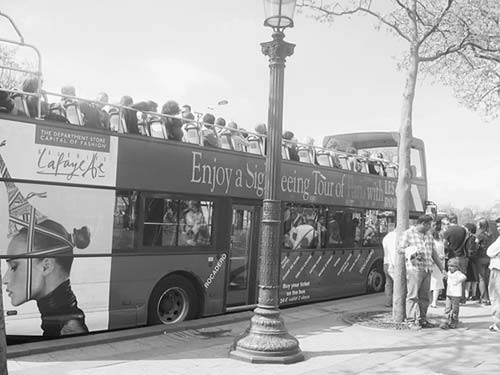
Big Bus Paris runs a fleet of buses around Paris on a route with just 10 stops and recorded narration (1 day-€30, 2 days-€34, kids 4-12-€16, 10 percent cheaper if you book online, tel. 01 53 95 39 53, www.bigbustours.com).
Paris’ cheapest “bus tour” is simply to hop on city bus #69 and follow my commentary.  See the Bus #69 Sightseeing Tour chapter.
See the Bus #69 Sightseeing Tour chapter.
Several companies run one-hour boat cruises on the Seine. For the best experience, cruise at twilight or after dark. (To dine while you cruise, see “Dinner Cruises” on here.) Two of the companies—Bateaux-Mouches and Bateaux Parisiens—are convenient to Rue Cler hotels, and both run daily year-round (April-Oct 10:00-22:30, 2-3/hour; Nov-March shorter hours, runs hourly). Some offer discounts for early online bookings.
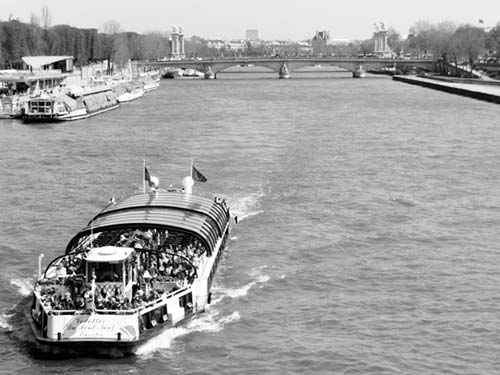
Bateaux-Mouches, the oldest boat company in Paris, departs from Pont de l’Alma’s right bank and has the biggest open-top, double-decker boats (higher up means better views). But this company caters to tour groups, making their boats jammed and noisy (€13.50, kids 4-12-€5.50, tel. 01 42 25 96 10, www.bateaux-mouches.fr).
Bateaux Parisiens has smaller covered boats with handheld audioguides, fewer crowds, and only one deck. It leaves from right in front of the Eiffel Tower (€13, kids 3-12-€5, tel. 01 76 64 14 45, www.bateauxparisiens.com).
Vedettes du Pont Neuf offers essentially the same one-hour tour as the other companies, but starts and ends at Pont Neuf, closer to recommended hotels in the Marais and Luxembourg Garden neighborhoods. The boats feature a live guide whose delivery (in English and French) is as stiff as a recorded narration—and as hard to understand, given the quality of their sound system (€14, €12 if you book direct with this book in 2016, discounts for online bookings, kids 4-12-€7, tip requested, nearly 2/hour, daily 10:30-22:30, tel. 01 46 33 98 38, www.vedettesdupontneuf.com).
Batobus allows you to get on and off as often as you like at any of eight popular stops along the Seine. The boats, which make a continuous circuit, stop in this order: Eiffel Tower, Orsay Museum, St. Germain-des-Prés, Notre-Dame, Jardin des Plantes, Hôtel de Ville, the Louvre, and Pont Alexandre III, near the Champs-Elysées (1 day-€16, 2 days-€18, April-Aug boats run every 20 minutes 10:00-21:30, Sept-March every 25 minutes 10:00-19:00, 45 minutes one-way, 1.5-hour round-trip, www.batobus.com). If you use this for getting around—sort of a scenic, floating alternative to the Métro—it can be worthwhile, but if you just want a guided boat tour, the Seine cruises described earlier are a better choice. Combo-tickets covering the L’OpenTour hop-on, hop-off buses (described earlier) are available, but skip the one-day ticket—you’ll feel rushed trying to take full advantage of the bus and boat routes in a single day.
Canauxrama runs a lazy 2.5-hour cruise on a peaceful canal out of sight of the Seine. Tours start from Place de la Bastille and end at Bassin de la Villette (near Mo: Stalingrad). During the first segment, you’ll pass through a long tunnel (built by order of Napoleon in the early 19th century, when canal boats were vital for industrial transport). Once outside, you glide—not much faster than you can walk—through sleepy Parisian neighborhoods and slowly climb through four double locks as a guide narrates in French and English (adults-€17, kids 12 and under-€9, check online for discounts for advance booking, departs at 9:45 and 14:30 across from Opéra Bastille, just below Boulevard de la Bastille, opposite #50—where the canal meets Place de la Bastille, tel. 01 42 39 15 00, www.canauxrama.com). The same tour also goes in the opposite direction, from Bassin de la Villette to Place de la Bastille (usually departs at 9:45 and 14:45). It’s OK to bring a picnic on board.
For food-oriented walking tours, see here.
Paris Walks offers a variety of thoughtful and entertaining two-hour walks, led by British and American guides (€12-20, generally 2/day—morning and afternoon, private tours available, family guides and Louvre tours are a specialty, best to check current offerings on their website, tel. 01 48 09 21 40, www.paris-walks.com). Tours focus on the Marais, Montmartre, medieval Latin Quarter, Ile de la Cité/Notre-Dame, the “Two Islands” (Ile de la Cité and Ile St. Louis), the Revolution, and Hemingway’s Paris. They also run less-frequent tours to the Puces St. Ouen flea market and the Catacombs, in addition to tours on WWI and WWII topics. Reservations aren’t necessary for most tours, but specialty tours—such as the Louvre, fashion, or chocolate tours—require advance reservations and prepayment with credit card (deposits are nonrefundable).
Context Travel offers “intellectual by design” walking tours geared for serious learners. The tours are led by well-versed docents (historians, architects, and academics) and cover both museums and specific neighborhoods. They range from traditional topics such as French art history in the Louvre and the Gothic architecture of Notre-Dame to more thematic explorations like immigration and the changing face of Paris, jazz in the Latin Quarter, and the history of the baguette. It’s best to book in advance—groups are limited to six participants and can fill up fast (€70-105/person, admission to sights extra, generally 3 hours, tel. 09 75 18 04 15, US tel. 800-691-6036, www.contexttravel.com). They also offer private tours and excursions outside Paris.
Fat Tire Tours offers lowbrow, lighter-on-information but high-on-fun walking tours (run by Fat Tire Bike Tours). Their 3.5-hour Classic Walk covers most major sights (€20, usually at 10:00—see website for days of week; meet at their office at 24 Rue Edgar Faure, Mo: Dupleix, tel. 01 82 88 80 94, www.fattiretours.com/paris). They also offer neighborhood walks of Montmartre, the Marais (includes entry to Picasso Museum), and the Latin Quarter, as well as themed walks on the French Revolution (most tours-€20, Marais/Picasso tour-€36, tours run several times a week—see website for details). The company promises a €2 discount on all walks with this book (two-discount maximum per book).
Fat Tire also runs skip-the-line tours (called Easy Pass) of major sights, including the Louvre, Notre-Dame Tower, Catacombs, Eiffel Tower, Orsay, Sainte-Chapelle, Picasso Museum, and Versailles (€40-85/person, includes entry and guided tour). Reservations are required and can be made online, by phone, or in person at their office near the Eiffel Tower (daily 9:00-18:00, longer hours in high season, 36 Avenue de la Bourdonnais, Mo: Ecole Militaire, tel. 01 82 88 80 94, www.fattiretours.com/paris). Their Eiffel Tower options are handy if you’re otherwise unable to get advance tickets.
For many, Paris merits hiring a Parisian as a personal guide. Thierry Gauduchon is a terrific guide and a gifted teacher (€230/half-day, €450/day, tel. 06 19 07 30 77, tgauduchon@gmail.com). Sylvie Moreau also leads good tours in Paris (€200 for 3 hours, €320 for 7 hours, tel. 01 74 30 27 46, mobile 06 87 02 80 67, sylvie.ja.moreau@gmail.com). Arnaud Servignat is a fine guide who has taught me much about Paris (private tours starting at €180, also does car tours of the countryside around Paris for a little more, mobile 06 68 80 29 05, www.french-guide.com, arnotour@me.com). Elisabeth Van Hest is another likable and very capable guide (€200/half-day, tel. 01 43 41 47 31, mobile 06 77 80 19 89, elisa.guide@gmail.com). Sylviane Ceneray is gentle and knowledgeable (€200/half-day, tel. 06 84 48 02 44, www.paris-asyoulikeit.com).
A bike tour is a fun way to see Paris. Two companies—Bike About Tours and Fat Tire Bike Tours—offer tours and bike maps of Paris, and give good advice on cycling routes in the city. Their tour routes cover different areas of the city, so avid cyclists could do both without much repetition.
Run by Christian (American) and Paul (New Zealander), Bike About Tours offers easygoing tours with a focus on the eastern half of the city. Their four-hour tours run daily year-round at 10:00 (also at 15:00 May-Sept). You’ll meet at the statue of Charlemagne in front of Notre-Dame, then walk nearby to get your bikes. The tour includes a good back-street visit of the Marais, Rive Gauche outdoor sculpture park, Ile de la Cité, heart of the Latin Quarter (with a lunch break), Louvre, Les Halles, and Pompidou Center. Group tours have a 12-person maximum—reserve online to guarantee a spot, or show up and take your chances (€30, 10 percent discount on this tour with this book, includes helmets upon request, private group tours available). Their private family tours of Paris include fun activities like scavenger hunts (€200 for 2 people, €25/person after that, complimentary boat-tour tickets—a €14 value—included, see listing on here). They also offer a day-trip bike tour of Versailles.
Over at Fat Tire Bike Tours, a gang of Anglophone expats offers an extensive program of bike, Segway (see below), and walking tours (see earlier). Their young guides run four-hour bike tours of Paris day and night (adults-€32, kids-€30 but must weigh at least 100 pounds, show this book for a €4 discount per person, maximum 2 discounts per book, reservations recommended but not required, especially in off-season). Kid-size bikes are available, as are tandem attachments that hook on to a parent’s bike. On the day tour, you’ll pedal with a pack of 10 to 20 riders, mostly in parks and along bike lanes, with a lunch stop in the Tuileries Garden (tours leave daily rain or shine at 11:00, April-Oct also at 15:00). Livelier night tours follow a route past floodlit monuments and include a boat cruise on the Seine (April-Oct daily at 19:00, less frequent in winter). Both tours meet at the exit of the Dupleix Métro station near the Eiffel Tower; from there you’ll walk to the nearby Fat Tire office to pick up bikes (helmets available on request at no extra charge; see listing on here). They also run bike tours to Versailles and Giverny (reservations required, see website for details).
Fat Tire offers pricey three-hour City Segway Tours. Learn to ride these stand-up motorized scooters while exploring Paris (you’ll get the hang of it after about a half-hour). These tours take no more than eight people at a time, so reservations are required (must be at least 12 years old or 90 pounds, €95, daily at 9:30, April-Oct also at 14:00 and 18:30, March and Nov also at 14:00, tel. 01 56 58 10 54, www.citysegwaytours.com).
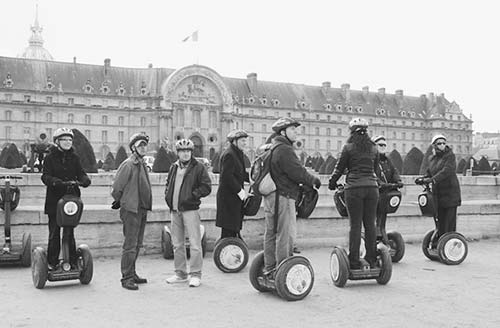
You’ll see TripUp’s space-age pedicabs (cyclopolitains) everywhere in central Paris. The hard-pedaling, free-spirited drivers (who get some electrical assistance) are happy to either transport you from point A to B or give you a tour at a snail’s pace—which is a lovely way to experience Paris (€40-50/hour, confirm approximate price in advance, www.tripup.fr).
Left Bank Scooters offers very small group tours of Paris, plus day trips outside the city. Their tour of Versailles is worth considering for motor scooter enthusiasts: You’ll meet in Paris, ride your scooter to Versailles on quiet roads, then do an all-day visit during which you are allowed to drive into the palace gardens (€250 for one person, €50 extra for passenger, tel. 06 78 12 04 24, www.leftbankscooters.com). They also do a Paris Highlights tour and a night tour of Paris (€150 for one person, €50 extra for passenger). Ask about their private tours of Paris on a vintage bike with sidecar (€200/half-day, €350/full-day). They will also deliver rental scooters to daring travelers over age 20 with a valid driver’s license (€70-100/day, price depends on size of the scooter’s motor).
Paris on Wheels provides services for travelers with disabilities, including city wheelchair tours, excursions from Paris, and transportation within the city—a terrific service, as public transportation is not wheelchair-accessible (tel. 06 68 23 74 38, www.parisonwheels.com, derek@parisonwheels.com).
Andy Steves (Rick’s son) runs Weekend Student Adventures (WSA Europe), offering three-day and longer guided and unguided packages—including accommodations, sightseeing, and unique local experiences—for student travelers in 12 top European cities, including Paris (guided trips from €199, see www.wsaeurope.com).
You’ll never run out of things to do in Paris, but the outlying areas may lure you out of the city. The grand châteaux at Versailles and Fontainebleau, the cathedral at Chartres, Monet’s garden at Giverny, and the artist town of Auvers-sur-Oise are all within reach as day trips. You can go on your own (for details, see the Day Trips from Paris chapter), or go with a local guide—most of the guides listed earlier will do excursion tours from Paris using your rental car.
It’s easy to arrange day trips from Paris to places around northern France, such as Reims, the Loire Valley, and the D-Day beaches of Normandy (all beyond the scope of this book, but well covered in Rick Steves France). Thanks to bullet trains and good local guides who can help you maximize your time, well-coordinated blitz-tour trips to these places are doable (though hardly relaxing). To see these places in a day, I recommend using a guide from the region who will meet you at the train station (most have cars) and show you the highlights before getting you back on your return train to Paris. Book well in advance, especially for the D-Day beaches.
Reims: The wine gurus at Ô Château in Paris offer day trips and tastings to Reims and Champagne (see here for contact info).
Loire Valley: Pascal Accolay runs Acco-Dispo, which offers good all-day château tours from the city of Tours—an hour from Paris by train (tel. 06 82 00 64 51, www.accodispo-tours.com).
D-Day Beaches: An army of small companies offers all-day excursions to the D-Day beaches from Bayeux or Caen, both reachable by train from Paris in 2.5 hours or less. Dale Booth, a fine historian and a riveting storyteller, will meet you at the Caen or Bayeux train station (tel. 02 33 71 53 76, www.dboothnormandytours.com, dboothholidays@sfr.fr) Normandy Battle Tours are led by Stuart Robertson, a gentle Brit who loves teaching visitors about the landings (ask about Paris pick-up, tel. 02 33 41 28 34, www.normandybattletours.com, enquiries@normandybattletours.com). Victory Tours offers informal and entertaining tours led by friendly Dutchman Roel (departs from Bayeux, tel. 02 31 51 98 14, www.victorytours.com, victorytours@orange.fr). Bayeux Shuttle takes individual signups for their minivan tours and has an easy booking calendar online (tel. 06 59 70 72 55, www.bayeuxshuttle.com). The Caen Memorial Museum’s “D-Day Tour” package includes pickup from the Caen train station, a guided tour through the WWII exhibits at the Memorial Museum, lunch, and then a five-hour afternoon tour in English (and French) of the major Anglo-American or Canadian beaches. Your day ends with a drop-off at the Caen train station in time to catch a train back to Paris (tel. 02 31 06 06 44, www.memorial-caen.fr).
If you’d be happier letting someone else arrange the logistics, the following companies offer convenient transportation and a smidgeon of guiding to destinations outside Paris.
Paris Webservices, a reliable outfit, offers day trips with English-speaking chauffeur-guides in cushy minivans for private groups to all the destinations covered in this book (figure €90-120/person for groups of 4 or more, use promo code “PW5TOR16” and show current edition of this book for discounts of 5 percent—discount valid only for their tours, tel. 01 45 56 91 67, www.pariswebservices.com, contactpws@pariswebservices.com).
City Vision runs tours to several popular regional destinations, including the Loire Valley, Champagne region, D-Day beaches, and Mont St-Michel (tel. 01 42 60 30 01, www.pariscityvision.com). Their minivan tours are pricier, but more personal and given in English, and most offer convenient pickup at your Paris hotel (half-day tour about €80/person, all-day tour about €190/person). Their full-size bus tours are multilingual, mass-marketed, and mediocre at best, but can be worthwhile for some travelers simply for the ease of transportation to the sights (about €80-170, destinations include Versailles, Giverny, Mont St-Michel, and more).